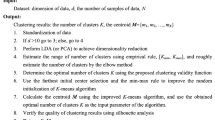Abstract
Reduced K-means (RKM) and Factorial K-means (FKM) are two data reduction techniques incorporating principal component analysis and K-means into a unified methodology to obtain a reduced set of components for variables and an optimal partition for objects. RKM finds clusters in a reduced space by maximizing the between-clusters deviance without imposing any condition on the within-clusters deviance, so that clusters are isolated but they might be heterogeneous. On the other hand, FKM identifies clusters in a reduced space by minimizing the within-clusters deviance without imposing any condition on the between-clusters deviance. Thus, clusters are homogeneous, but they might not be isolated. The two techniques give different results because the total deviance in the reduced space for the two methodologies is not constant; hence the minimization of the within-clusters deviance is not equivalent to the maximization of the between-clusters deviance. In this paper a modification of the two techniques is introduced to avoid the afore mentioned weaknesses. It is shown that the two modified methods give the same results, thus merging RKM and FKM into a new methodology. It is called Factor Discriminant K-means (FDKM), because it combines Linear Discriminant Analysis and K-means. The paper examines several theoretical properties of FDKM and its performances with a simulation study. An application on real-world data is presented to show the features of FDKM.
Similar content being viewed by others
References
Bock, H.H. (1987), “On the Interface Between Cluster Analysis, Principal Components, and Multidimensional Scaling”, in: Multivariate Statistical Modeling and Data Analysis, Proceedings of Advances Symposium on Multivariate Modeling and Data Analysis, Knoxville, Tennessee, May 15–16, 1986, eds. H. Bozdogan and A.J. Gupta, Dordrecht: Reidel Publishing Co., pp. 17–34.
Caliński, T., and Harabasz, J. (1974), “A Dendrite Method for Cluster Analysis”, Communications in Statistics, 3, 1–27.
Cormack, R. M. (1971), “A Review of Classification”, Journal of the Royal Statistical Society. Series A, 134(3), 321–367.
De Soete, G., and Carroll, J.D., (1994). “K-means Clustering in a Low-dimensional Euclidean Space”, in New Approaches in Classification and Data Analysis, eds. E. Diday et al., Heidelberg: Springer, pp. 212–219.
Diday, E., et al. (1979), “Optimisation en classification automatique”, INRIA (Vol. 1), Rocquencourt, France.
Forina, M., Lear, R., Armanino, C., and Lauter, S. (1988), PARVUS – An Extendible Package for Data Exploration, Classification and Correlation, Institute of Pharmaceutical and Food Analysis and Technologies, Genoa, Italy.
Hubert, L., and Arabie, P. (1985), Comparing Partitions. Journal of Classification, 2, 193–218.
Timmerman, M., Ceulemans, E., Kiers, H.A.L., and Vichi, M. (2010), Factorial and Reduced K-means Reconsidered, Computational Statistics and Data Analysis, 54, 1858–1871.
Van Buuren, S., and Heiser, W.J. (1989), “Clustering n Objects into k groups Under Optimal Scaling of Variables”, Psychometrika, 54, 699–706.
Vichi, M., and Kiers, H.A.L. (2001), “Factorial K-means Analysis for Two-way Data”, Computational Statistics and Data Analysis, 37, 49–64.
Vichi, M., Rocci, R., and Kiers, H.A.L. (2007), “Simultaneous Component and Clustering Models for Three-way Data: Within and Between Approaches”, Journal of Classification, 24(1), 71–98.
Author information
Authors and Affiliations
Corresponding author
Rights and permissions
About this article
Cite this article
Rocci, R., Gattone, S.A. & Vichi, M. A New Dimension Reduction Method: Factor Discriminant K-means. J Classif 28, 210–226 (2011). https://doi.org/10.1007/s00357-011-9085-9
Published:
Issue Date:
DOI: https://doi.org/10.1007/s00357-011-9085-9




